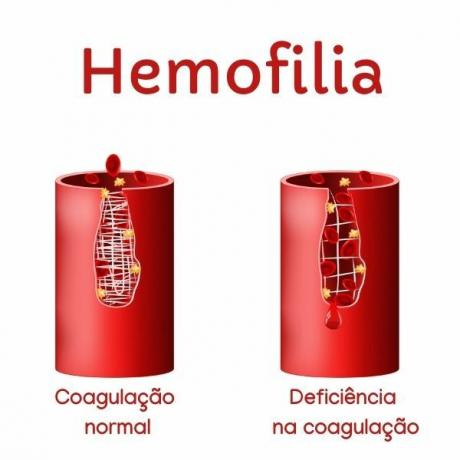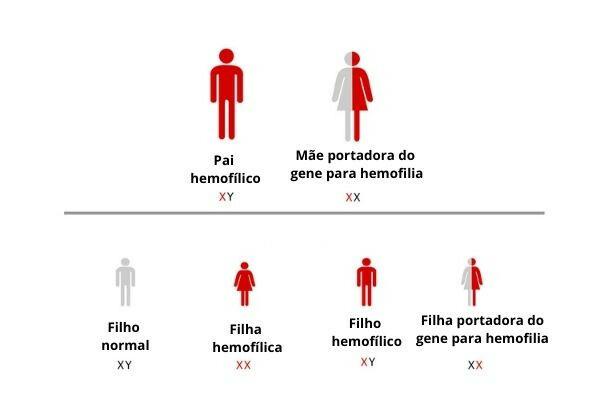THE hemophilia is a disease linked to chromosome X which is characterized by causing disturbances in the coagulation. Patients with this problem have prolonged bleeding and, in some cases, even spontaneously. It is also known as “blue blood disease” for having affected several royal families in Europe and Russia. The treatment is based on the replacement of deficient coagulation factors and allows the patient to have a practically normal life. Treatment for hemophilia is not curative.
Read too: Basic concepts for studying genetics
What is hemophilia?
Hemophilia is a disease that causes prolonged bleeding due to abnormalities or deficiency in the activity of clotting factors, especially factors VIII and IX. The clotting factors are nothing more than proteins related to the blood clotting process, which act to stop hemorrhages.
Hemophilia is not contagious and affects men more frequently, being very rare in women. The disease is known to be hereditary, but there is also the so-called acquired hemophilia, which is rare and has an autoimmune origin.

Types of Hemophilia
We can classify hemophilia into two main types:
- Hemophilia A: it is the most common type and represents about 80% of cases. It shows a deficiency in the activity of the factor VIII. Hemophilia A affects 1 in every 5,000 to 10,000 males born.
- Hemophilia B: characterized by the deficiency of the factor IX. It has an estimated prevalence of 1 case in every 30,000 to 40,000 men born.
hemophilia manifests itself in different ways in each individual and can be classified according to severe, moderate, and mild clotting factor levels.
- Severe hemophilia: has very little clotting factor activity (factor VIII or IX activity is less than 1%) and therefore has an increased risk of bleeding. In these patients, muscle and joint hemorrhages are common. In addition, bleeding can occur spontaneously and after minor trauma.
- Moderate hemophilia: in it, the activity of the clotting factor is also quite low, being between 2% and 5%. Bleeding can occur after minor trauma, with spontaneous bleeding being infrequent.
- Mild hemophilia: in it, the activity of factor VIII or IX is between 5% and 40%, therefore, it causes less bleeding than the mentioned types. Bleeding in these cases occurs after major trauma or surgical procedures. It is not common for spontaneous bleeds to occur.
Read more: Blood - special type of connective tissue, is contained in the cardiovascular system
Signs and Symptoms of Hemophilia
Hemophilia affects the individual's clotting, which makes minor traumas a big problem. THE main clinical manifestation of hemophilia is bleeding, which can be internal or external. Bleeding can occur, for example, in the joints, being known as hemarthrosis, or in the subcutaneous region, skin and muscles, causing the emergence of bruises.
In severe cases, bleeding can occur without an apparent cause, being triggered even by daily activities such as walking, running and performing domestic activities. A potentially dangerous clinical manifestation is intracranial hemorrhage, which can cause headaches that do not stop with the use of common analgesics, mental confusion, irritability, drowsiness, convulsions, and loss of consciousness.
The genetics of hereditary hemophilia
Hereditary hemophilia is a genetic disease triggered by an X-linked recessive allele. As we know, men have an X chromosome and a Y chromosome. Women, in turn, have two X chromosomes. For hemophilia to express itself in women, it is necessary that they have two alleles for the disease (XHXH), since it is a recessive inheritance.
When a woman has only one allele for the disease, she is considered normal, but a carrier (XHXH). Men, on the other hand, can be just normal or hemophiliacs. Because they only have one X chromosome, it is enough that this chromosome has the allele for the disease for the individual to be hemophilic (XHY). Due to this reason, hemophilia affects men more frequently.

It is noteworthy that, in most cases, the disease occurs in an inherited form. However, in some situations, it occurs without a known history of hemophilia in the family, resulting from mutations.
Read too: X-linked inheritance
Diagnosis of hemophilia
Hemophilia is diagnosed by observing the patient's clinical picture and performing specific blood tests, such as measuring the coagulation activity of clotting factors and tests that allow the assessment of clotting time and the identification of the clotting factor that is missing.
Usually hemophilia is identified in childhood, being noticed due to the appearance of hematomas as soon as the child starts to crawl and walk and due to prolonged bleeding in front of little ones traumas. In general, severe hemophilias are easier to be diagnosed than mild or moderate ones, as signs and symptoms tend to be more subtle.
Hemophilia treatment
Soon after diagnosis, it is essential to start treatment in order to correct clotting problems. The treatment of hemophilia is based on replacement of deficient clotting factors, this being done under medical supervision. The clotting factors used in this process are obtained from human blood or even through genetic engineering techniques. Treatment for hemophilia is offered free of charge by SUS and it is important to ensure that the patient has a quality of life.
Physical activity and hemophilia
Many people have doubts about the performance of physical activities by hemophiliac individuals. THE physical activity is essential for all human beings, presenting great health benefits, being no different for the hemophiliac. In general, it is recommended that the hemophiliac do not play sports that involve physical impact, like football, in order to avoid possible bleeding.
However, it is important to make it clear that each individual should talk to their doctor to assess what would be the ideal activity. Among the activities that can be released by the doctor, walking, swimming, water aerobics and weight training stand out.
By Vanessa Sardinha dos Santos
Biology teacher

